MURDER
a catalogue of thirty-five rare books
CASSIUS&Co.

CASSIUS&Co.
Spanning from 1920 to 1940 circa, the ‘Golden Age of Detective Fiction’ marked a period characterized by murder mystery novels with similar patterns and style. It comes as no surprise that many of the titles featured in this catalogue hail from those years. However, the roots of the detective fiction genre trace back to the nineteenth century with the work of Edgar Allan Poe, widely considered its inventor, and the appearance in 1887 of arguably the most iconic detective in world literature, Mr. Sherlock Holmes. Sir Arthur Conan Doyle’s creation skyrocketed him to becoming one of the best-selling authors of his time, and the overwhelming popularity of Holmes famously led to his resurrection despite attempts at a graceful exit. In 1905, a formidable adversary to Holmes emerged: Arsène Lupin, the ‘gentleman thief’. Holmes’s appearance in one of Maurice Leblanc’s early stories prompted legal action from Conan Doyle, resulting in the English detective’s name being thinly disguised in subsequent editions as ‘Holmlock Shears’.
This concise catalogue showcases some of the most iconic heroes and villains within the genre. Two characters, both Chinese, take centre stage: Sax Rohmer’s super villain, the sinister Dr. Fu Manchu, and Robert van Gulik’s ingenious, semi-fictional, Judge Dee. Despite their divergent roles and the varied intentions of their creators, both characters epitomized the early twentieth-century Western fascination with Asia, albeit often clouded by prejudices against ‘otherness’. Nevertheless, they served as a conduit for exploring another culture, particularly evident in Van Gulik’s scholarly and literary pursuits. As a diplomat, he immersed himself in Asian art and culture,
translating the initial Judge Dee stories from their original Chinese and even illustrating his novels in the style of classical Ming woodcuts.
Following the tumult of the Second World War, the crime fiction genre endured, albeit with some setbacks. In the 1970s, amidst the backdrop of the American Civil Rights Movement, a notable addition emerged in the form of John Shaft, an AfricanAmerican detective from Harlem. Shaft’s widespread popularity sparked film and television adaptations, and earned author Ernest Tidyman the distinction of being one of the few white individuals to win an award from the National Association for the Advancement of Colored People.
All items listed are subject to availability, and payment is required in advance. Prices include delivery within the UK, while overseas delivery costs, if applicable, will be confirmed separately by the gallery. For any inquiries, please feel free to contact us directly via email.
Guido G. Beduschi Books and Manuscripts Specialist, CASSIUS&Co. gb@cassiusandco.co1. BAILEY, H. C. Mr. Fortune Explains. London, Ward, Lock & Co., 1930. [and:]
_. Case for Mr. Fortune. London, Ward, Lock & Co., 1932. [and:]
_. Mr. Fortune Wonders. London, Ward, Lock & Co., 1933.
Three first editions of these collections of short mystery stories featuring brilliant detective Reggie Fortune, an eccentric surgeon working for Scotland Yard.
A drama critic and war correspondent in World War I, Bailey became one of the most-read writers of the Golden Age of detective fiction. He authored widely divergent, dark stories, involving multiple homicides, disappearances, police corruption, and obstruction of justice.
Each volume contains eight stories.
Three octavo volumes: Mr. Fortune Explains, pp. 320, in publisher’s green cloth, lettered and ruled in black; Case for Mr. Fortune, pp. 320, in publisher’s olive-green cloth, lettered and ruled in black; Mr. Fortune Wonders, pp. 316, in publisher’s brown cloth, lettered and ruled in black. All volumes lacking the dust wrappers. Some light, variable browning and a few stains, binding a little rubbed and scuffed, but overall very good reading copies.
£400

First edition, uncommon, of this comprehensive study of Sherlock Holmes.
The book is ‘an attempt … to systematise our knowledge of Holmes’s character and work, and to present a picture that does justice to the original and conforms with the strict requirements of modern biographical method’ (blurb).
Octavo, pp. 133, [1]; very good; blue cloth, spine lettered in gilt, with the original printed dust jacket (spine sunned, some spotting to edges and jacket).
£300

First edition, scarce, of this collection of twenty-one short stories, in the original dust jacket illustrated by the British artist Mary Ellen Edwards.
The Specimen Case is a collection of twenty-one short stories written by Bramah over three decades. Two stories feature his most successful characters, the Chinese storyteller Kai Lung (‘Ming-Tsuen and the Emergency’) and the blind detective Max Carrados (‘The Bunch of Violets’). The sci-fi story ‘The War Hawks’ serves as a sequel to his influential novel What Might Have Been (1907), acknowledged by George Orwell for its impact on Nineteen Eighty-Four
Ernest Bramah, the pseudonym of Ernest Brammah Smith, was a prolific author of humorous, detective, science fiction and supernatural stories.
Octavo, pp. 320; near fine; original red cloth, titles in blind to front cover, lettered in black to spine, with the original pictorial dust jacket (spine slightly sunned, jacket very lightly soiled, with a few nicks to edges).
£1,100

4. CHESTERTON, G. K. Four Faultless Felons. New York, Dodd, Mead & Company, 1930
First US edition, retaining the original, very rare, Art Deco dust jacket by the American artist Arthur Hawkins.
Four Faultless Felons comprises four long crime stories, each featuring a character (a ‘faultless felon’) who commits a crime for what they believe to be a morally justifiable reason. Together, these four stories ‘reveal Chesterton as a delightful entertainer, a brilliant and unconventional thinker, and one of the most capable authors in the entire field of deductive and analytical writing’ (blurb).
Octavo, pp. 298; near fine, in peach-coloured publisher’s cloth, lettered and ruled in black and green, printed flyleaves and pastedowns, printed dust jacket (spine slightly faded).
£1,800

5. COLE, G. D. H., and Margaret COLE. The Man from the River. New York, The Macmillan Company, 1928.
First US edition in fine dust jacket of this novel, jointly written by the socialist couple G. D. H and Maragaret Cole.
Superintendent Henry Wilson of Scotland Yard sets off for the tranquil town of Steeple-Tollesbury, hoping for a carefree vacation. However, his plans take an unexpected turn as he discovers that all is not well in Steeple-Tollesbury…
G. D. H. Cole, a professor of social and political theory at Oxford, and Margaret Cole, an author and political reformer, were both prominent members of the Fabian Society. Together, they authored twenty-nine books of detective fiction, often set within a university or country house, with Superintendent Henry Wilson as the principal detective.
Octavo, pp. 302; near fine; green cloth, lettered in red to spine and front board, upper edge tinted purple, other edges untrimmed, green illustrated endpapers, printed dust jacket, front flaps with publisher’s decorative trim to corners (extremities slightly rubbed, spine lightly sunned).
£600
 6. CONAN DOYLE, Arthur. The Hound of the Baskervilles. London, George Newnes, 1902
6. CONAN DOYLE, Arthur. The Hound of the Baskervilles. London, George Newnes, 1902
First edition in book form, first impression, of Sherlock Holmes’s literary return after ‘The Final Problem’.
‘Based on a local legend of a spectral hound that haunted Dartmoor in Devonshire, the story is set in the moors at Baskerville Hall … and the action takes place mostly at night, when the terrifying hound howls for blood. After Sir Charles Baskerville is found dead with his face twisted in stark terror, Holmes is called upon to protect his heir, Sir Henry Baskerville…’ (Britannica).
The story was initially serialized in the Strand Magazine from August 1901 to April 1902. Although The Hound of the Baskervilles was published nearly a decade after the story ‘The Final Problem’, the events unfold before the detective’s shocking ‘death’ at the Reichenbach Falls.
Octavo, pp. 358, [1]; frontispiece (lacking tissue guard) and fifteen plates by Sidney Paget; tiny worm hole at end not affecting text, a very good copy; original red cloth, lettering and art nouveau decoration in gilt by Alfred Garth Jones to spine and cover (signed ‘A. J. G.’), on front cover incorporating black silhouette of hound, top edge red (some light foxing, spine a little sunned).
£8,500

A new edition of Conan Doyle’s second novel featuring Sherlock Holmes.
Holmes claims that his mind ‘rebels at stagnation’, when Miss Mary Morstan arrives with a new case… The story was first published in Lippincott’s Monthly Magazine in February 1890, under the title The Sign of the Four, and was released in book form in October 1890, with the title The Sign of Four. In the following British and American editions, including the present 1900 edition, the second ‘the’ of the original title was omitted.
Octavo, pp. 285; very good in contemporary half calf with grey boards, spine lettered in gilt, top edge gilt, marbled endpapers (some light foxing, lean to spine, spine lightly sunned, extremities and boards slightly rubbed); a few pencil annotations, bookplate to front pastedown with name erased, bookseller’s stamp ‘Hatchards 187 Piccadilly’ on verso of front flyleaf.
£150

First UK edition of Connolly’s debut novel.
In 1990s London, a 29-year-old drug dealer intends to abandon his life of crime upon turning thirty to pursue the life of a ‘gentleman of leisure’. However, his retirement plans take an unexpected turn...
This story was adapted into a 2004 film directed by Matthew Vaughn, with Daniel Craig starring in the lead role.
Octavo, pp. 309; near fine; original illustrated wrappers (some creasing to covers).
£75
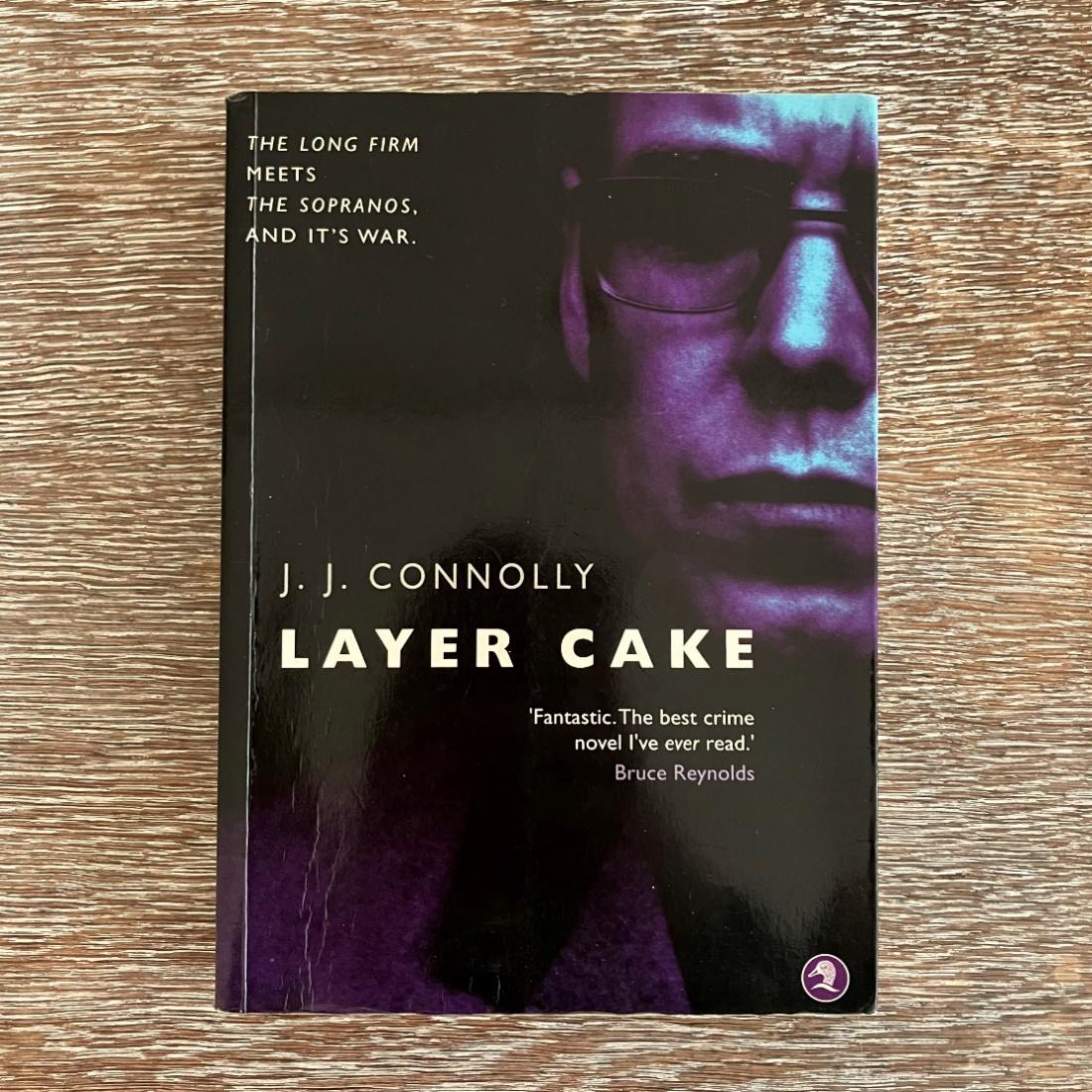
9. FREEMAN, R. Austin. The Penrose Mystery. London, Hodder & Stoughton, 1936
First edition of Freeman’s seventeenth novel featuring forensic investigator Dr John Evelyn Thorndyke.
After the eccentric collector of antiquities, Daniel Penrose, mysteriously disappears, Dr Thorndyke is summoned to investigate.
British writer Richard Austin Freeman is credited with inventing the inverted detective story, a narrative style where the crime and its perpetrator are revealed at the outset, with the subsequent plot focusing on the detective’s efforts to unravel the mystery. As a colonial surgeon, Freeman drew on his own experiences in crafting his novels. His Dr Thorndyke stories often incorporate authentic yet arcane scientific details, such as those related to tropical medicine and toxicology.
Octavo, pp. 317; near fine; blue cloth, lettered in black to front cover and spine, upper edge stained blue, with the original printed dust jacket (spine ends lightly sunned, extremities a little rubbed, jacket spine sunned).
£850
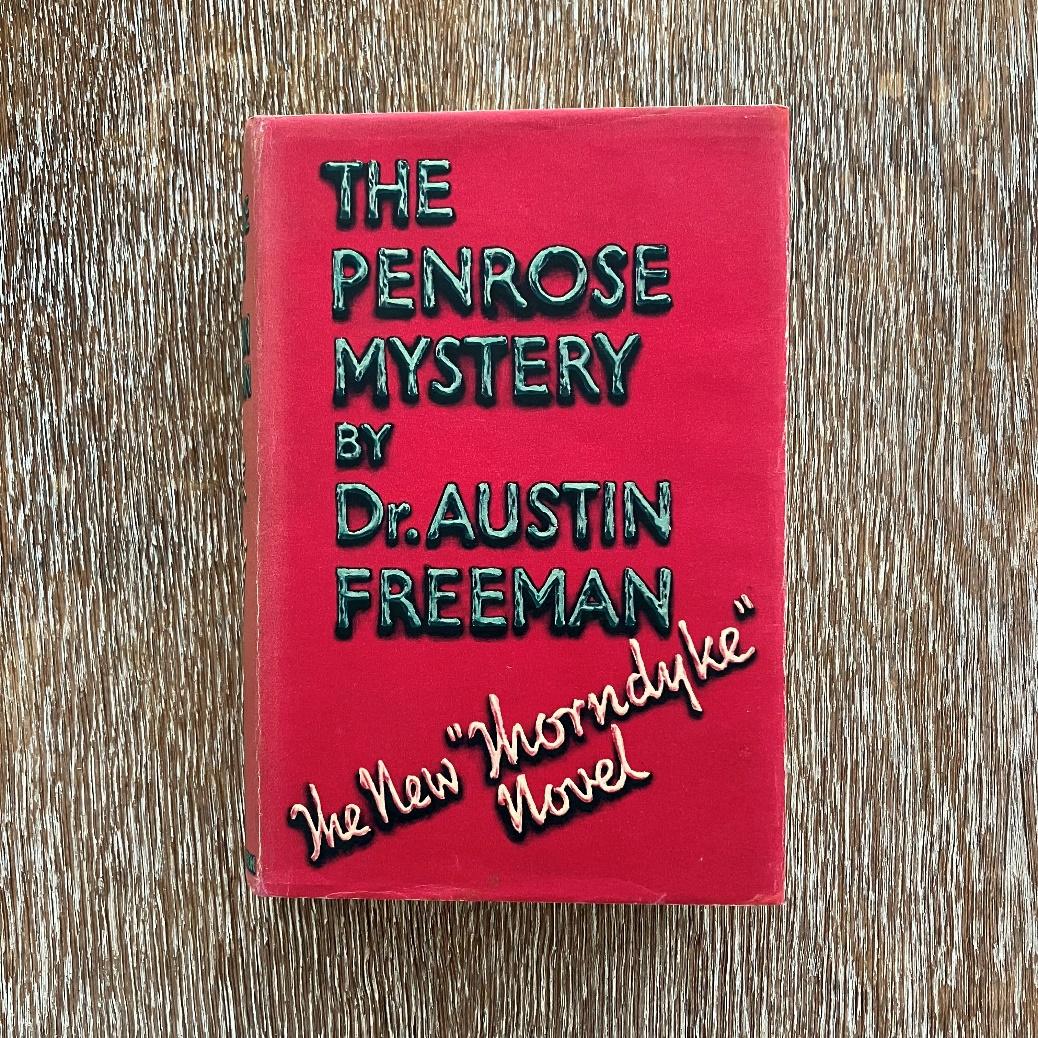
First UK edition, very rare, of this crime novel set in Chinatown. ‘Jacob Mandra has been murdered by a queer device, a Chinese sleeve-gun…’. Gardner rose to become one of the world’s best-selling authors, primarily known for his series featuring detective Perry Mason. Murder Up My Sleeve is one of his two novels centred around Terry Clane, a ‘new sleuth with new methods’.
Octavo, pp. 280; some spotting to edges but generally very good; green cloth, titles printed in black to spine, in very good pictorial dust jacket (some fading to spine, especially at head, jacket with a few nicks to top edge).
£3,000

First edition of Hawk’s classic crime story.
‘An ingenious and romantic mystery’ set on a huge ocean liner and starring private detective Mortimer Sark. The great cover-design just about pristine.
Octavo, pp. 301; near fine, in orange-coloured publisher’s cloth, lettered in black, printed dust jacket (extremities slightly worn); a few pencil annotations, Dinkytown Antiquarian Bookstore, Minneapolis label on rear pastedown.
£300
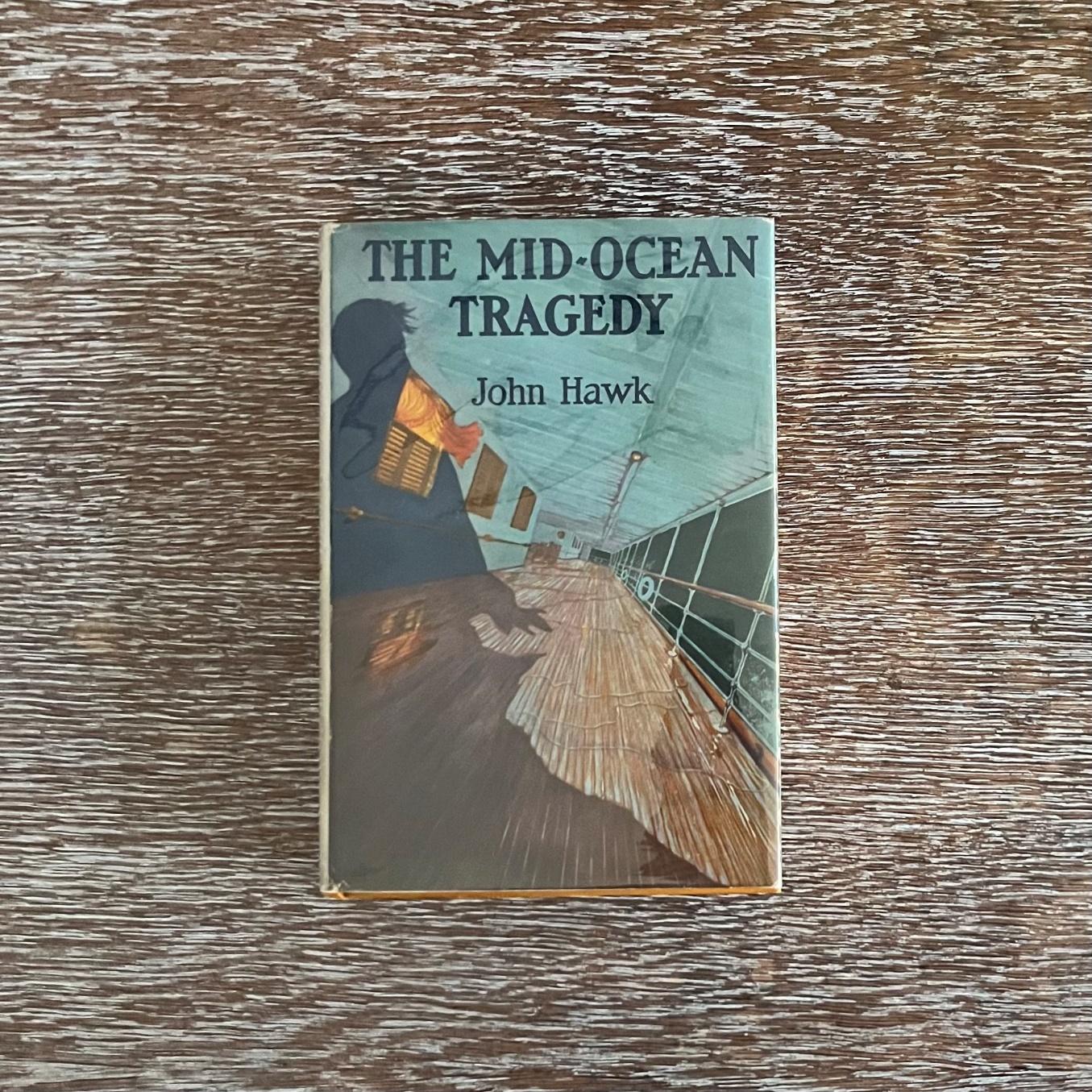
12. KENNEDY, Robert Milward [i.e. Milward KENNEDY and A. G. MACDONELL].
The Bleston Mystery. New York, Doubleday, Doran & Company for the Crime Club, 1929.
First US edition of this detective story cowritten by Milward Kennedy and A. G. Macdonnell.
‘The subjects involved are blackmail, international spying, and hidden treasure; and there are a considerable number of murders – quite admirable murders’ (blurb).
The Bleston Mystery stands as the only collaboration between Kennedy and Macdonnell and is the debut novel of both authors. An English civil servant, crime writer and journalist, Kennedy served with the British military intelligence during the First World War. Macdonnell, on the other hand, was a Scottish writer, journalist and broadcaster, best known for his 1933 satirical classic England, Their England Octavo, pp. 301; near fine; black cloth lettered in red to front cover and spine, with a facsimile dust jacket (spine ends slightly rubbed); ink stamp of ‘M. R. Keith’ to rear pastedown.
£400

13. LEBLANC, Maurice; Alexander TRIXEIRA [TEXEIRA]
The Exploits of Arsène Lupin. New York, Harper and Brothers, 1907.
(translator).
First US edition of this collection of stories, marking the debut of the gentleman thief Arsène Lupin.
Published in French as Arsène Lupin, Gentleman-Cambrioleur in 1907, the book comprises nine short stories which had already appeared in the monthly magazine Je Sais Tout between July 1905 and May 1907. The first UK edition appeared in June 1907 under the title Arsène Lupin, Gentleman Burglar, preceding this US edition by four months. The ninth story, titled ‘Sherlock Holmes Arrives too Late’ in the UK edition, sparked a dispute with the lawyers of Sir Arthur Conan Doyle. Consequently, in this and subsequent editions, the story’s title was altered to ‘Holmlock Shears Arrives too Late’.
Octavo, pp. 314; some light foxing but generally very good; original dark blue cloth, printed in black and yellow, no dust jacket (extremities lightly rubbed); bookseller’s ticket ‘Chas. E. Lauriat Co. … Boston’ to front flyleaf.
£850

14. LEBLANC, Maurice; Edgar JEPSON (translator). Arsène Lupin. From the Play by Maurice Leblanc and Francis de Croisset. London, Mills and Boon, 1909.
First edition, in the scarce dust jacket, of this English translation of Leblanc’s novel, with a photographic portrait of the author to the front cover.
The story originally appeared as a four-part play by Maurice Leblanc and Francis de Croisset, a Belgian-born French playwright and opera librettist. Titled Arsène Lupin, the play premiered on 28 October 1908 at the Théâtre de l’Athénée in Paris and met with considerable success. It was subsequently adapted into a novel by Leblanc and published in French in 1909. The same year saw the release of this English translation by Edgar Jepson, author of adventure and detective fiction.
Octavo, pp. 344, 32; an excellent copy; original black cloth, titles to spine gilt and to front board in red, small photographic portrait of the author to front board, with the printed dust jacket (spine slightly rolled, edges lightly foxed, dust jacket with browned spine panel, shallow chips and tears to extremities and repairs to verso).
£3,000

15. LEBLANC, Maurice; Alexander TEXEIRA DE MATTOS (translator). The Confessions of Arsène Lupin. New York, Doubleday, Page and Company, 1913.
First US edition of Leblanc’s sixth novel recounting the adventures of the gentleman thief Arsène Lupin with four illustrations.
Following Leblanc’s dark-themed novel 813, this book presented readers with lighter stories reminiscent of those found in the first collection of the series, Arsène Lupin, Gentleman Burglar. The original French edition contained nine short stories, one fewer than this English version.
Octavo, pp. 327, with four B/W illustrations by J. Henry; near fine; original blue cloth lettered in gilt with an illustration to front board, no dust jacket (extremities very lightly rubbed).
£400

16. LEBLANC, Maurice. The Return of Arsène Lupin. New York, Macaulay, 1933
First US edition of Leblanc’s twenty-second novel recounting the adventures of the gentleman thief Arsène Lupin, in the scarce dust jacket.
Published that same year in French under the title Victor, de la Brigade Mondaine, the book narrates the relentless pursuit of Lupin by inspector Victor of the Special Branch, a cunning old detective who spent a large part of his career in the colonies.
Octavo, pp. 256; near fine; black wrapper printed in yellow, with the original illustrated dust jacket (extremities very lightly rubbed, jacket slightly soiled with extremities a little worn and head of spine chipped).
£700

First joint edition of Le Carré’s first two novels, Call for the Dead and A Murder of Quality, in the original bright dust jacket.
Following the success of The Spy Who Came in from the Cold (1963), two of Le Carré’s earlier novels were re-released together for the first time in The Le Carré Omnibus. Originally published in 1961, Call for the Dead is the author’s debut novel; it introduces his recurring character George Smiley and ‘the Circus’, a fictional version of British Intelligence based on MI6. A Murder of Quality, Le Carré’s second novel from 1962, continues Smiley’s story and is his only book set outside the espionage community.
Octavo, pp. 288; near fine; red cloth, spine lettered in gilt, near fine yellow dust jacket printed in black and red (dust jacket slightly creased and stained, trace of sticker to spine).
£650

.
Second impression of Rivett’s twenty-fourth novel featuring Chief Inspector MacDonald of Scotland Yard, with a dust jacket designed by J. Z. Atkinson. The story unfolds in rural Lancashire against the backdrop of the Second World War. When Robert Garth, the patriarch of the Garth family, is discovered dead, Scotland Yard sends MacDonald to the north to investigate.
Edith Caroline Rivett was a prominent British author of the Golden Age of Detective Fiction. She published under the pseudonyms E. C. R. Lorac, Carol Carnac, and Mary Le Bourne.
Octavo, pp. 160; near fine; red cloth, lettered in black to spine, with the original printed dust jacket (spine slightly rolled, spine ends sunned, jacket lightly spotted, sunned at spine, with a few nicks to lower edge and a short closed tear to head of rear joint).
£150
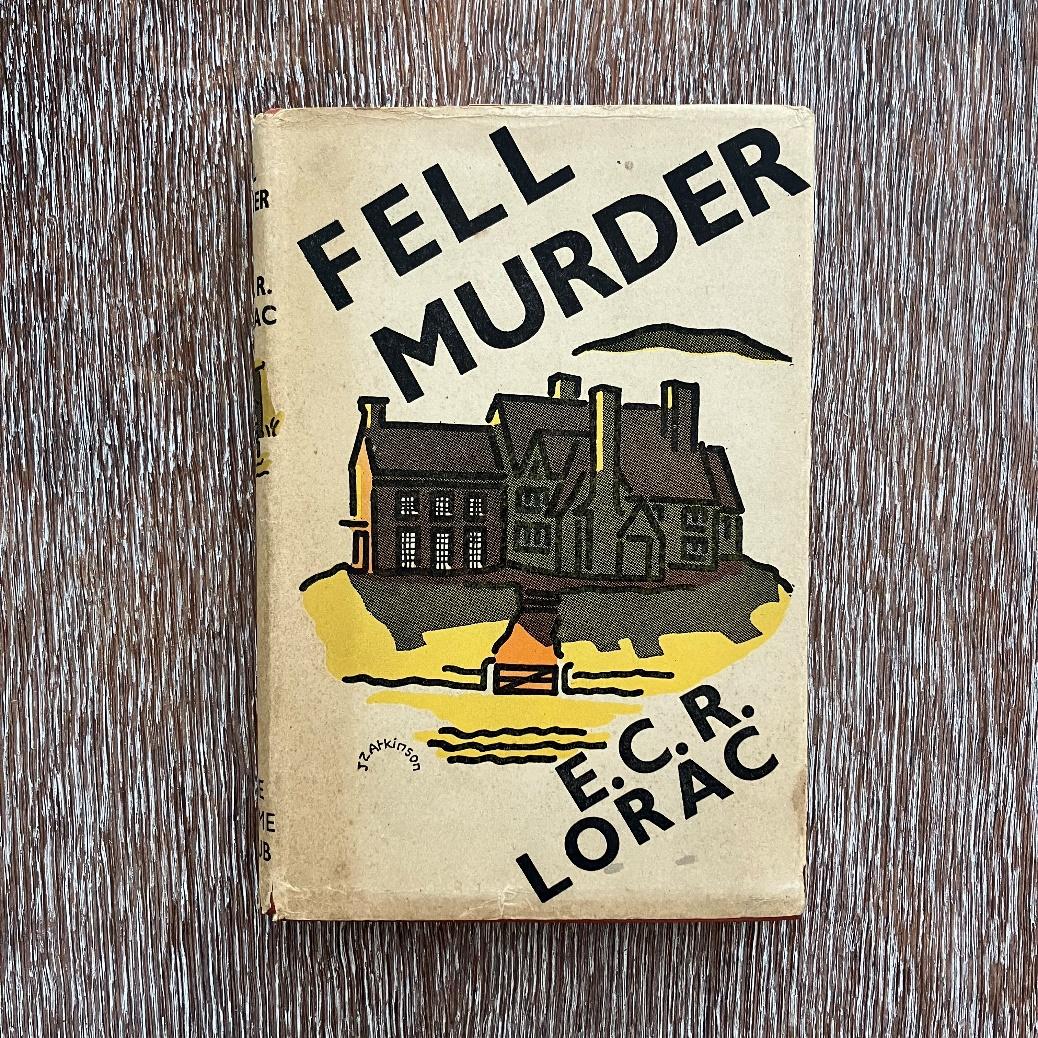 18. LORAC, E. C. R [i.e. Edith Caroline RIVETT]. Fell Murder. London, Collins for the Crime Club, 1947
18. LORAC, E. C. R [i.e. Edith Caroline RIVETT]. Fell Murder. London, Collins for the Crime Club, 1947
Scarce first edition of this detective story set in 1930s Rome.
Reporter Tony Grant finds himself standing atop the Spanish Steps in Rome when a beautiful young woman approaches him, claiming past acquaintance...
McGuire was an Australian diplomat and author. His works include several detective stories, a book of verse, and an essay on the poetry of Gerard Manley Hopkins. After the war, he relocated to Rome where he assumed the role of Australian Ambassador to Italy.
Octavo, pp. 282; near fine; orange cloth, lettered in black to spine, with the original printed dust jacket (spine of jacket lightly sunned, jacket clipped to lower corner of front flap).
£400
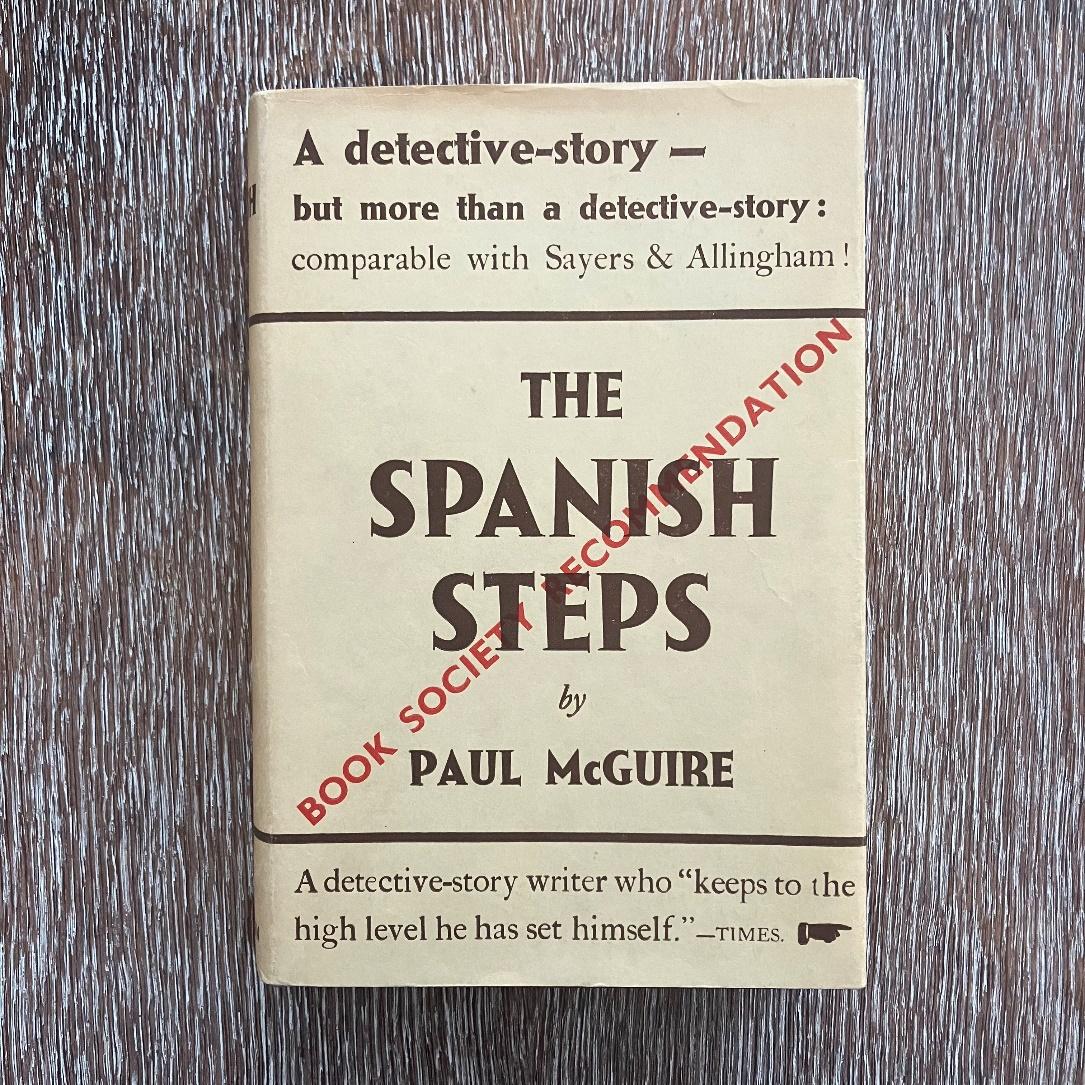
First edition, scarce, of the third Fu-Manchu title.
Spanning from Fu Manchu’s first appearance in 1912, Rohmer authored a series of fourteen novels featuring the Chinese supervillain. Inscrutable and sinister, Fu Manchu orchestrates crimes through his minions and employs arcane methods, including the use of poisonous animals and natural chemical weapons. The character’s immediate success stemmed from his embodiment of ‘the genre of the “yellow peril” mystery, which expressed Western fears of the expansion of Asian power and influence’ (Britannica). Fu Manchu appeared in several silent and sound films, radio, and comic strips. Sax Rohmer was the pseudonym of British writer Arthur Henry Ward.
Octavo, pp. 306, 31; very good; original rust coloured cloth, lettered in black to the upper board and spine (lean to spine, some spotting to edges of text block, spine very lightly sunned with head and tail bumped); bookseller’s ticket ‘W. H. Smith & Son … Paris’ to front pastedown; ‘Ex libris T. L. Demon’ inked to front flyleaf.
£350

First edition of Rohmer’s last novel published before his death, in a near fine dust jacket.
‘Once you pass the Second Bamboo Curtain, McKay, unless my theories are all haywire, you will be up against the greatest scientific criminal genius who has ever threatened the world…’
The inscrutable and sinister Chinese supervillain Dr. Fu Manchu masterminds crimes through his minions, utilizing arcane methods such as poisonous animals and natural chemical weapons. The immense popularity of Rohmer’s character stemmed from his embodiment of the ‘yellow peril’ mystery genre, which reflected ‘Western fears of the expansion of Asian power and influence’ (Britannica).
Sax Rohmer was the pseudonym of British writer Arthur Henry Ward.
Octavo, pp. 221; near fine; red cloth, spine lettered in black, with the pictorial dust jacket (head and foot of spine a little bumped, extremities of jacket a little worn, price clipped).
£250

22. ROHMER, Sax. Five Fu Manchu reprints. London, Cassel & Co., 1956-57
A 1950s set of five novels featuring Chinese supervillain Fu Manchu, with colourful pictorial dust jackets.
[Consisting of:]
- The Bride of Fu Manchu. Fifth edition 1957 (first edition 1933).
- The Trail of Fu Manchu. Edition 1957 (first edition 1934).
- President Fu Manchu. Edition 1957 (first edition 1936).
- The Drums of Fu Manchu. Edition 1956 (first edition 1939)
- The Island of Fu Manchu. Edition 1956 (first edition 1941)
Dr. Fu Manchu is the mysterious Chinese super villain in a series of fourteen novels by Sax Rohmer. The character’s huge popularity stemmed from his embodiment of the ‘yellow peril’ mystery genre, which echoed Western fears of Asian power. Fu Manchu’s impact extended to film, radio, and comics. Sax Rohmer was the pseudonym of British writer Arthur Henry Ward.
Five octavo volumes; all very good; original coloured cloth, spine lettered, with the pictorial dust jackets (some light spotting to edges of text blocks, jackets slightly soiled and creased, spines variably sunned, extremities a little worn).
£450

23. ROHMER, Sax. Yu’an Hee See Laughs. New York, Doubleday, Doran & Company for The Crime Club, 1932.
First edition of this novel introducing Rohmer’s super villain Yu’an Hee See, very scarce in the original dust jacket designed by George Annand a featuring the author’s photograph.
An enigmatic figure known as Yu’an Hee See spearheads an international criminal syndicate involved in drug smuggling, jewellery theft, and human trafficking. Scotland Yard detective Dawson Haig finds himself facing a daunting challenge with scant leads to pursue, leaving him to navigate the case largely on his own…
Sax Rohmer was the pseudonym of British writer Arthur Henry Ward, best known for his Fu Manchu series.
Octavo, pp. 312; near fine; black cloth, lettering to front cover and spine in yellow, top edge stained yellow, other edges untrimmed, in very good pictorial dust jacket, including a photograph of the author on the rear (spine ends gently rolled, jacket with a few nicks to edges and small old tape repair to top edge, spine lightly sunned); bookplate of Helen Linn to front flyleaf, stamped ‘MD 200’ to rear flyleaf.
£500
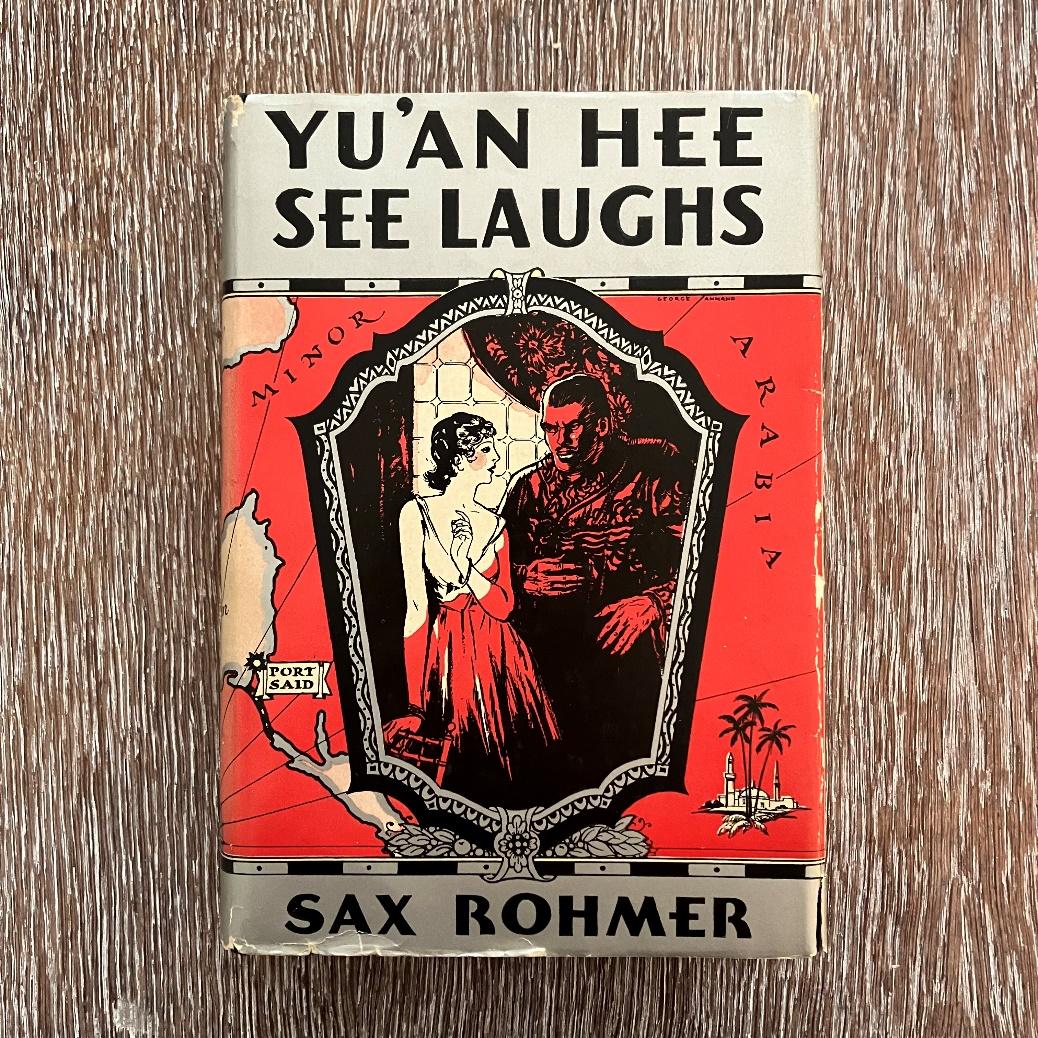
First edition of this spy fiction novel set in Egypt, very scarce in the original pictorial dust jacket.
Secret agent Larry Tabrer is sent to Egypt to bust an international drug ring, headed by a mysterious organisation known as ‘The Five’. But things get complicated when he falls for Musette, a dancer with possible ties to the gang…
Sax Rohmer was the pseudonym of British writer Arthur Henry Ward, best known for his Fu Manchu series.
Octavo, pp. 337; near fine; yellow cloth, lettered and decorated in black to spine, top edge stained yellow, other edges untrimmed, with the original pictorial dust jacket (spine ends slightly rolled and rubbed, jacket with a few nicks to edges, spine lightly sunned).
£500

First edition of this novel introducing private investigator John Shaft, in a handsome jacket designed by Mozelle Thompson.
John Shaft is an African-American private investigator based in New York City. ‘He’s the loner. The rock-existentialist from Harlem. The beautiful black with soul, guts, and hormones. Shaft’s the name and the game’ (blurb).
Shaft quickly gained popularity, with six more books by Tidyman published between 1971 and 1975, and three films and a television series starring Richard Roundtree as John Shaft. The franchise saw a revival in recent years, with two additional films and a novel released between 2000 and 2019.
For creating the Shaft series, Tidyman became one of the few white individuals to win an award from the NAACP (National Association for the Advancement of Colored People).
Octavo, pp. 188; near fine; red cloth, spine lettered in gilt, top edge trimmed, fore and bottom edges untrimmed, white dust jacket printed in black and red (head of spine bumped, spotting to edges of text block, jacket with short closed tear to foot of front joint); in a contemporary custom-made slipcase.
£375

Solved by Judge Dee. Tokyo, Privately printed for the author by Toppan Printing, 1949.
First edition, number 700 of 1200 copies, signed by the author and with his seal.
Van Gulik was a Dutch orientalist and diplomat. This book features his first stories, which he translated from an anonymous eighteenth-century Chinese account during the Second World War. Later, he used it as the basis to create his own original Judge Dee series.
‘This branch of literature [detective novels] was fully developed in China several centuries before Edgar Allan Poe or Sir Arthur Conan Doyle were born’ (preface). Judge Dee was loosely based on a real-life Tang dynasty statesman, Di Renjie (630-700). For this first edition, Van Gulik drew six plates after ancient Chinese models.
Octavo, pp. 237; frontispiece portrait of Judge Dee, illustrated; original pictorial woodcut-decorated boards (boards slightly worn, especially at edges, spine chipped at head); bookplate of Douglas B. O’Connell and inscription ‘Hong Kong August 1953’ to front flyleaf.
£1,500
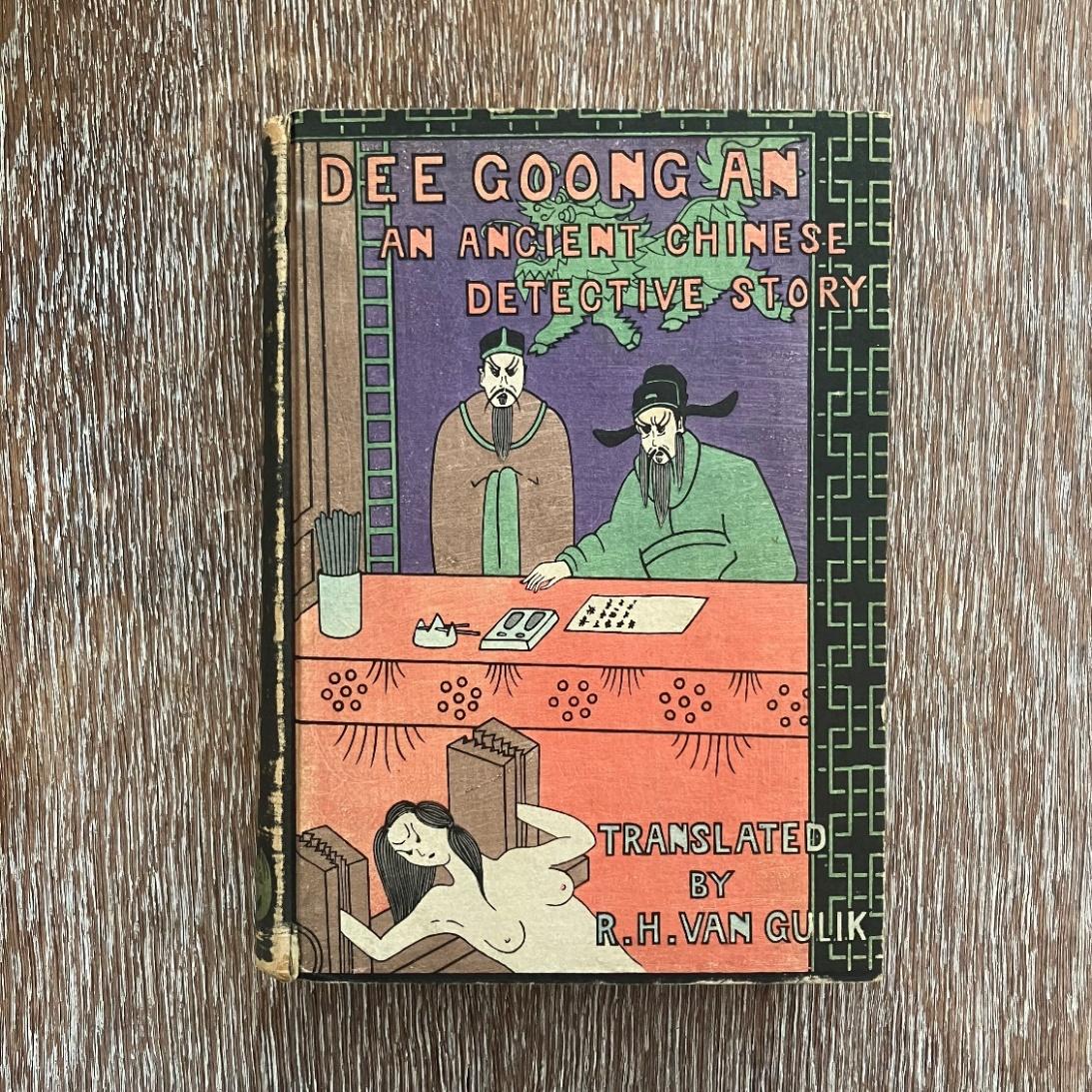
27. VAN GULIK, Robert. The Chinese Maze Murders: A Chinese Detective Story Suggested by Three Original Ancient Chinese Plots. Singapore, Eastern Universities Press, 1956.
First English-language edition of Van Gulik’s first fictional Judge Dee stories, with exquisite illustrations by the author.
‘Now in my opinion antiquity has no detective that can compare with Judge Dee. For many years I have been sedulously collecting notes about the cases solved by his brilliant mind…’.
The Chinese Maze Murders comprises three mysteries drawn from authentic Chinese murder casebooks and centres around the semi-fictional character Judge Dee, loosely inspired by the Tang magistrate and statesman Di Renjie (630-700). Originally published in Japanese in 1951, a Chinese edition was released two years later.
Robert van Gulik was a Dutch orientalist and diplomat.
Octavo, pp. 322, with 19 plates drawn by the author; near fine; original black cloth lettered and decorated in red to front cover and spine, illustrated pastedown and flyleaves, with the original dust jacket illustrated by the author (some spotting to edges, spine ends gently rolled, jacket lightly stained, spine sunned, a few nicks to edges, short closed tear to foot of front joint); bookseller’s ticket ‘City Book Store Ltd Singapore – K Lumpur’ to front pastedown.
£600
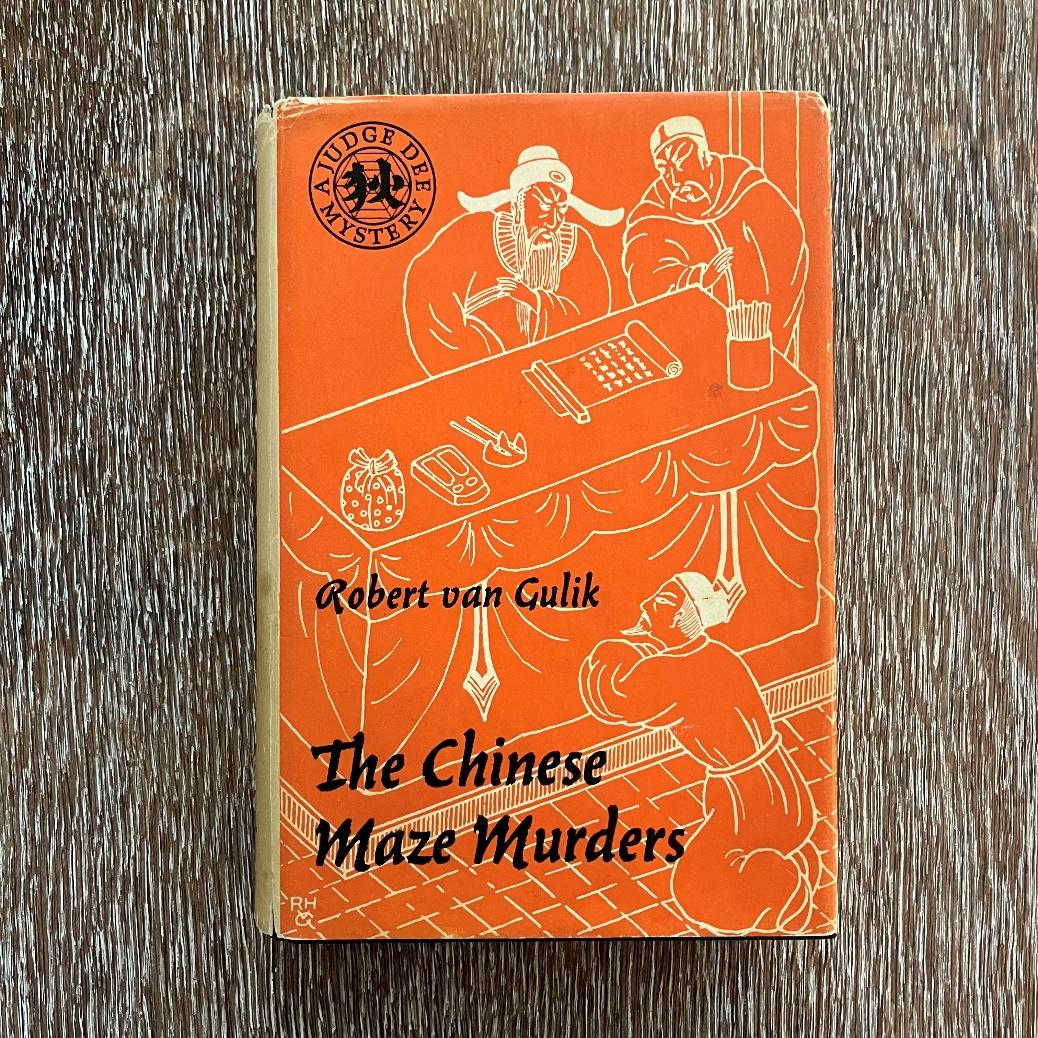
Robert. The Chinese Bell Murders:
Cases Solved by Judge Dee –Uncorrected Proof Copy. London, Michael Joseph, 1958.
Uncorrected proof of the first edition of Van Gulik’s second Judge Dee title, with exquisite illustrations by the author.
‘I at last found time to devote myself entirely to my favourite pastime, namely collecting material on the history of crime and detection…’.
The Chinese Bell Murders comprises three mysteries featuring the semi-fictional character Judge Dee, loosely inspired by the Tang magistrate and statesman Di Renjie (630-700). Originally aimed at a Japanese or Chinese readership, it eventually saw publication in English.
Robert van Gulik was a Dutch orientalist and diplomat.
Octavo, pp. 288, with 15 plates drawn by the author in Chinese style; slightly worn but internally very good; original cream wrappers printed in black to front cover and spine, label ‘PROOF COPY for inspection … March 3rd 1958’ glued to front wrapper (covers and spine slightly worn and creased, lightly soiled, titles on front cover partly retraced with pen); front cover stamped ‘17 FEB 1958’.
£900

29. VAN GULIK, Robert. The Chinese Lake Murders: Three Cases Solved by Judge Dee –Uncorrected Proof Copy. London, Michael Joseph, 1960.
Uncorrected proof of the first edition of these Judge Dee mysteries, with exquisite illustrations by the author.
‘When a judge is seated behind his scarlet bench, his is the power of Heaven, over life and death – but not Heaven’s knowledge…’.
The Chinese Lake Murders comprises three mysteries featuring the semi-fictional character Judge Dee, loosely inspired by the Tang magistrate and statesman Di Renjie (630-700). Initially aimed at a Japanese or Chinese readership, it was written around the same time as The Chinese Bell Murders but remained unpublished for several years.
Robert van Gulik was a Dutch orientalist and diplomat.
Octavo, pp. 270, with 12 plates drawn by the author in Chinese style; very good; original cream wrappers printed in black to front cover and spine (wrappers slightly soiled, some creasing to spine).
£900

30. VAN GULIK, Robert. The Haunted Monastery – Uncorrected Proof Copy. London, Heinemann, 1963.
Uncorrected proof of the first UK edition of this Judge Dee mystery taking place in a Taoist monastery.
‘It’s the largest Taoist monastery in the entire province, and many people visit it during the religious feasts. I am sure they’ll have good quest quarters…’.
The Haunted Monastery features the semi-fictional character Judge Dee, loosely inspired by the Tang magistrate and statesman Di Renjie (630-700). The Heinemann reissue followed the 1961 first edition by Art Printing Works in Kuala Lumpur.
Robert van Gulik was a Dutch orientalist and diplomat.
Octavo, pp. 160, with 8 plates drawn by the author in Chinese style; very good; original green wrappers printed in black to front cover and spine (some light dampstaining to lower corner of first few leaves, some spotting to edges, wrappers slightly creased, head of spine chipped).
£900

31. VAN GULIK, Robert. The Haunted Monastery: A Chinese Detective Story. Kuala Lumpur, Art Printing Works, 1961.
First edition, very scarce, of this Judge Dee mystery taking place in a Taoist monastery, with exquisite illustrations by the author.
‘It’s the largest Taoist monastery in the entire province, and many people visit it during the religious feasts. I am sure they’ll have good quest quarters…’.
The Haunted Monastery features the semi-fictional character Judge Dee, loosely inspired by the Tang magistrate and statesman Di Renjie (630-700). After the publication of The Chinese Nail Murders in the same year, Van Gulik encountered reluctance from his London publisher Michael Joseph to publish another title. Consequently, he opted to privately publish The Haunted Monastery through the Art Printing Works in Kuala Lumpur.
Robert van Gulik was a Dutch orientalist and diplomat.
Octavo, pp. 168, with 8 plates drawn by the author in Chinese style; very good; original card wrappers, front wrapper and spine yellow lettered in red and white, front wrapper illustrated by the author, rear wrapper white lettered in black, illustrated flyleaves (wrappers slightly soiled and creased, edges a little rubbed, spine lightly sunned).
£400

32. VAN GULIK, Robert. The Lacquer Screen: A Chinese Detective Story. Kuala Lumpur, Art Printing Works, 1962
First edition, very scarce, of this Judge Dee mystery, exquisitely illustrated by the author himself.
‘He saw the high lacquer screen standing against the wall opposite. Quickly he averted his gaze, but the screen seemed to move round together with his eyes…’.
The Lacquer Screen features the semi-fictional character Judge Dee, loosely inspired by the Tang magistrate and statesman Di Renjie (630-700). Van Gulik, encountering reluctance from his London publisher Michael Joseph to release more than one title a year, opted to privately publish The Lacquer Screen, as well as The Haunted Monastery and The Red Pavilion, through the Art Printing Works in Kuala Lumpur.
Robert van Gulik was a Dutch orientalist and diplomat.
Octavo, pp. 185 with 10 plates drawn by the author in Chinese style; very good; original card wrappers, front wrapper and spine red lettered in white, front wrapper illustrated by the author, rear wrapper white lettered in black, illustrated pastedowns and flyleaves (wrappers slightly rubbed and soiled, spine a little sunned).
£395

33. VAN GULIK, Robert. The Red Pavilion: A Chinese Detective Story. Kuala Lumpur, Art Printing Works, 1962.
Second edition of this Judge Dee mystery, exquisitely illustrated by the author himself.
‘He took the judge back to the antechamber and unlocked the solid door on the left, using a key of intricate pattern. “Why such an elaborate lock”, Judge Dee asked. “One rarely finds locks on inside doors…”’.
The Red Pavilion comprises three mysteries featuring the semi-fictional character Judge Dee, loosely inspired by the Tang magistrate and statesman Di Renjie (630-700). Van Gulik, encountering reluctance from his London publisher Michael Joseph to release more than one title a year, opted to privately publish The Red Pavilion, as well as The Haunted Monastery and The Lacquer Screen, through the Art Printing Works in Kuala Lumpur.
Robert van Gulik was a Dutch orientalist and diplomat.
Octavo, pp. 200, with 6 plates drawn by the author in Chinese style; very good; original card wrappers, front wrapper and spine black lettered in red and white, front wrapper illustrated by the author, rear wrapper white lettered in black, illustrated pastedowns and flyleaves (wrappers slightly rubbed and soiled, some creasing).
£300

34. VAN GULIK, Robert. The Willow Pattern: A Chinese Detective Story. New York, Charles Scribner’s Sons, 1965.
First US edition of this Judge Dee mystery, exquisitely illustrated by the author himself.
‘“Heavens!” she panted as she let the mangled head drop onto the marble floor. “What a dead weight the old fool is! Here, help me to push him a little closer to the foot of the stair…”’.
The Willow Pattern features the semi-fictional character Judge Dee, loosely inspired by the Tang magistrate and statesman Di Renjie (630-700).
Robert van Gulik was a Dutch orientalist and diplomat.
Octavo, pp. 184, with 15 illustrations by the author inn Chinese style; near fine; turquoise blue cloth lettered in blue to spine, blue illustrated pastedown and flyleaves, with the original dust jacket (spine ends gently rolled, jacket slightly soiled and price-clipped); bookseller’s ticket ‘Paragon Book Gallery … New York’ to verso of rear flyleaf.
£250

35. VAN GULIK, Robert. The Given Day: An Amsterdam Mystery. Kuala Lumpur, Art Printing Works, 1964
First edition, very scarce, of Van Gulik’s only murder mystery with a modern-day setting.
‘I walk down the curved bridge, muttering a curse as I nearly lose my footing on the slippery cobblestones. Peering through the drizzle I see a reddish glow over a door farther down the street: the sign of a bar…’.
Set in 1960s Amsterdam, The Given Day unfolds over the course of just twenty hours, spanning from 28 to 29 February, during which the lives of several individuals are profoundly impacted.
Robert van Gulik was a Dutch orientalist and diplomat, best known for his Judge Dee series.
Octavo, pp. 132, with 7 blueprints designed by the author; very good; original card wrappers, covers white printed in grey, red, blue and black, spine blue lettered in white (covers slightly soiled, spine creased with tiny abrasion).
£600
